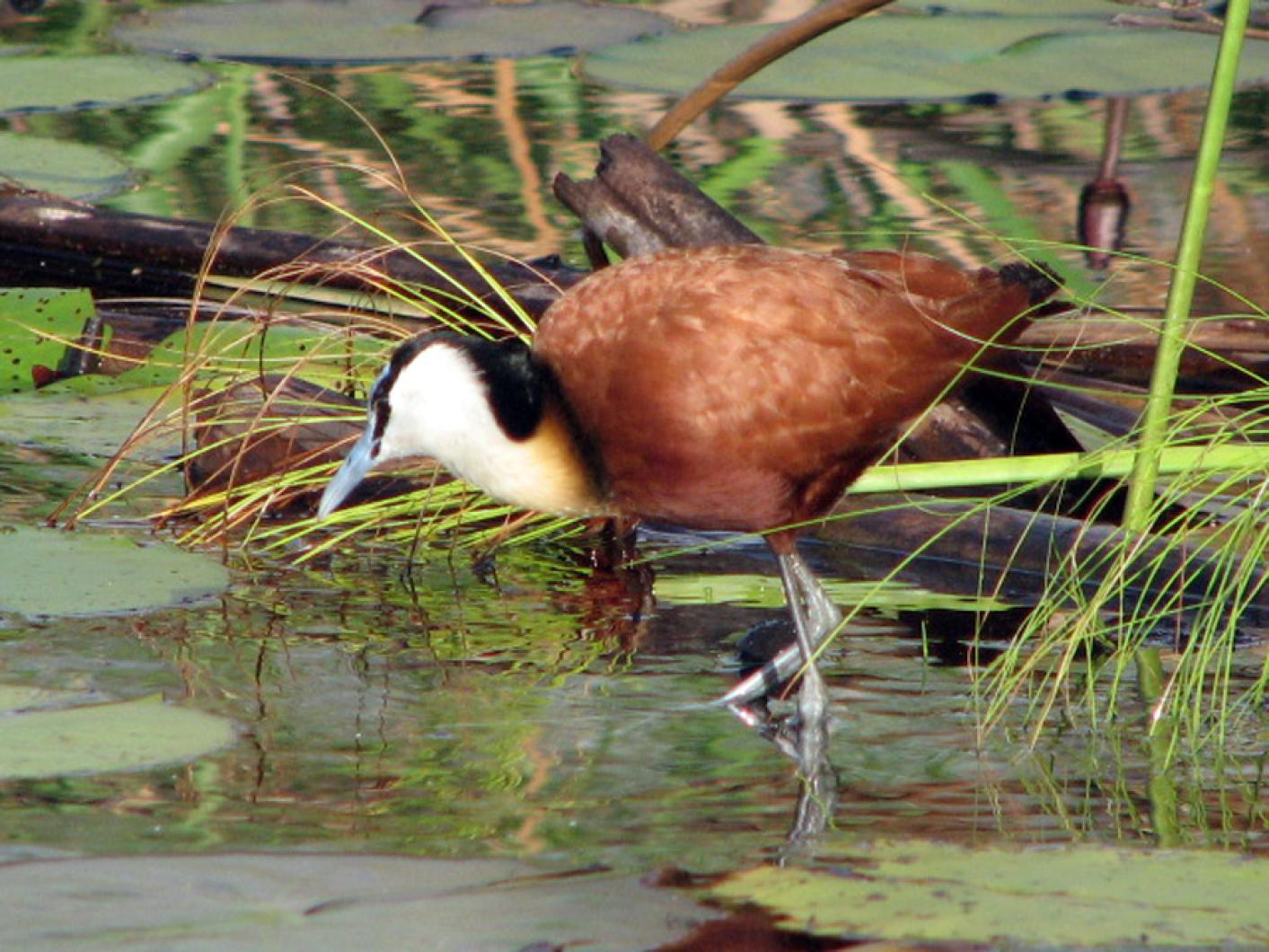The Okavango Delta was by far my favorite spot in Botswana and maybe of our whole Namibia/Botswana trip. I am not sure that Paul Magid and Anita Botti would agree, but Flip Harrington and I loved it. Our first tented camp was very strange, and if this had been our only stop my opinion of Botswana and the Okavango Delta would have been very different! We were greeted by three dogs of various mixed breeds. There was a tank of tilapia fish next to the desk where we checked in. When we returned from our tents after stowing our gear, there was an otter in the hall of the dinning area eating a fish. We sat down at the table for dinner and the otter scurried around our feet. Then, as we were about to be served, a full-grown goat appeared in the kitchen and promptly climbed up on a box about three feet square! This is where the goat was fed its bottle when young and has definitely been imprinted. Get on box, get fed. After dinner we went into the “lounge” to find the goat on a soft chair “sitting” next to the owner watching satellite TV. Oh, boy!
Our first trip into the waters of Okavango was on the Okavango River. We watched a family of hippopotamuses wallowing in the shallows, and Flip and Paul cast a few times to try to catch a tiger fish. The birding was good, herons of all sorts, weavers weaving interesting shaped nests from the grasses and rushes along the river’s edge. Fish eagles perched and crying, a sound somewhat reminiscent of great black-backed gulls, were grand. But my favorite spot and adventure of the trip was boating to and from a lodge in the Okavango Delta.
We left the “menagerie” and drove to a spot along the road where we met a driver with a truck that had been rigged with seating in the back and a canvas roof over same. We left our van and set off in the truck across a very flat sandy expanse. We drove until we could drive no more. We hit water, and there was a large open jon boat. We loaded our gear into the boat and were settling in when the boatman and Flip both mentioned that we were probably about to get rain. Some of us had rain gear, some didn’t. We rigged stylish and elegant large trash bags as rain coats. The luggage was covered with a tarpaulin. Off we went in the pouring rain, in shallow slews with herons taking off and lightning bolts flashing in the distance. What a beautiful scene. We made it to camp which was in the middle of the delta, settled in, and because it had stopped raining we went out in another boat to explore the delta. And explore we did, both that afternoon and early the following morning. Our best bird, in my opinion, was the white-backed night heron, but there were so many. Our trip list of birds for Namibia and Botswana was around 345 species of birds and 35 mammals. The experiences we had finding these creatures will be with us forever.
Bird Sightings:
I forgot to mention that Tim Baird spotted a peregrine falcon harassing the pigeons by a bridge on Sylvia State Beach on Feb. 18.
Scott Stephens found a fox sparrow feeding at the Roth Woodlands on March 2. The following day Penny Uhlendorf and Scott had two chipping sparrows, a common grackle and three pine siskins at their Pilot Hill feeder.
Robin Bray watched a flock of six horned larks feeding where the sand met the snow on the State Beach road on March 3.
Matt Pelikan was at the Farm Institute on March 4 and ventured within several yards of an elegant snowy owl. He also watched a flock of sixty horned larks feeding in the fallow fields. At Uncle Seth’s Pond on Lambert’s Cove Road, Matt found a great blue heron and a flock of ring-necked ducks. March 10 as Matt walked into work off Lambert’s Cove Road he spotted a brown creeper creeping up a tree.
Lanny McDowell freshly back from Florida hit Katama on March 5 where he spotted eastern bluebirds, eastern meadowlarks, yellow rumped warblers, northern flickers, a barn owl and a red-tailed hawk which was carrying what appeared to be a guinea fowl. Several days later on March 8, Lanny returned to Katama to find an early killdeer.
Laurie Walker, Katharine Colon and Sally Anderson were at Katama on March 7 and spotted numbers of dunlin, black-bellied plovers, four eastern meadowlarks, two snow geese and three red-tailed hawks. On March 8 at her house in Chilmark Laurie spotted a pine siskin and hairy woodpecker.
Joannie Ames called to report that at dusk on March 8 after a lovely Sunday, she was walking along Tisbury Lane East and heard the peenting and then the wing whistling of American woodcocks. She said when her children were young, finding and listening to the spring activities of the woodcocks was an annual event. Joannie also reported hearing what she thought was a great crested flycatcher on March 10. She felt it was way too early as there were no insects around. We figured it was probably a blue jay; they are mimics and have quite a repertoire.
I caught up with Julie and Barbara Ben David to find out what had been in their Oak Bluffs yard this winter. They have had red-breasted nuthatches all winter. In the last three weeks they had a pair of northern flickers. Regulars at their feeders include tufted titmice, two yellow-rumped warblers and Carolina wrens.
Please report your bird sightings to the Martha’s Vineyard Bird Hotline at 508-627-4922 or e-mail to birds@mvgazette.com.
Susan B. Whiting is the co-author of Vineyard Birds and Vineyard Birds II. She leads walks for the Chilmark Community Center and trips for Osprey Tours to Central and South America.





Comments
Comment policy »